Friday, October 22, 2010
Sauteed nagaimo 焼き長いも
I have posted quite a few dishes of nagaimo 長芋. You can make so many variations, either cooked or raw, but this grilled nagaimo with black pepper and salt has been featured not once but twice by the expert expats Izakaya connoisseurs and I decided to make my version. Since this was a weeknight, I did not charcoal grill the nagaimo but pan fried it.
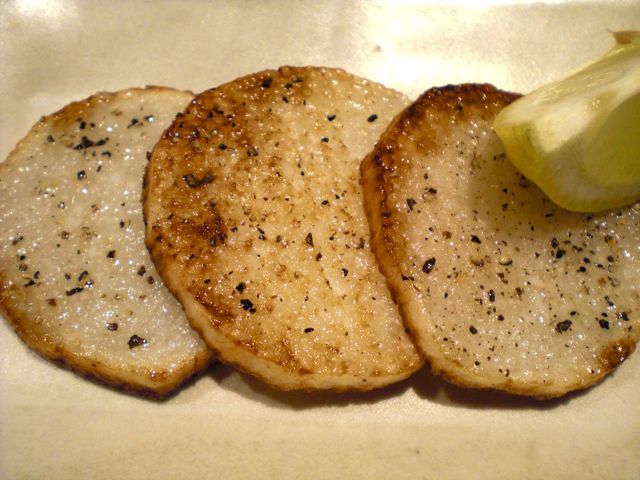
This dish is simple to make. Since I do not like the skin I removed it but you could keep the skin on. I sliced it into rather thin (1/4 inch) disks but this could be a bit thicker. I blotted any moisture from the surface using a paper towel. I added light olive oil (1 tbs) to a hot frying pan on medium-high flame and browned one side rather well (bottom side) for 2 minutes. I flipped it over and fried for 1 more minute. I flipped it over again and sprinkled salt and freshly cracked black pepper. You could use different seasoning such as Japanese 7 flavored red pepper 七味唐辛子, sansho 山椒, or even cumin or curry powder if you like.
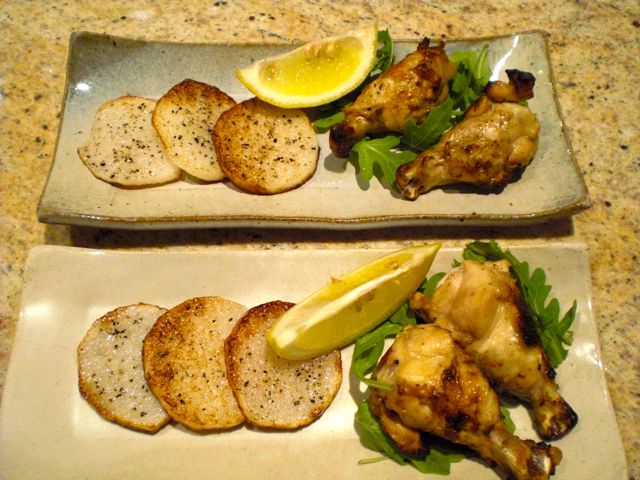
We had this as an opening dish with leftover yakitori drumettes reheated in a toaster oven as seen above. The nagaimo has a nice mild crunchy crust and becomes very sweet (some starch must convert to sugar). It is really satisfying and the salt and pepper make this dish. Nagaimo can be simmered in broth as well but I never posted it. Maybe that will be my next post on nagaimo.
Wednesday, October 20, 2010
Grilled Baby Octopus and grilled smashed potatoes 子鮹のグリルと焼き潰しジャガイモ
I don't think I've ever seen uncooked baby octopuses in a regular grocery store. Last time we went to the market to get pasteurized eggs, to our surprise, they had fresh baby octopuses. It was also very cheap (less than $5 per pound and I could not resist getting some). I decided to marinade them in both Western and Japanese styles and just grill them on a charcoal fire.
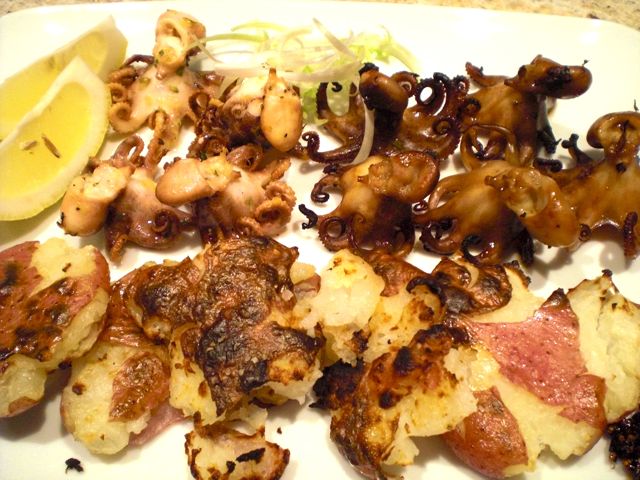
Western style Marinade: Lemon juice (from one medium lemon), lemon zest (from one lemon before squeezing its juice using a micrograter), olive oil (3-4 tbs), salt and pepper. I also added fresh thyme (finely chopped) from our herb garden.

Since we made perilla seedpod Tsukudani 紫蘇の実の佃煮, we tried it on the potatoes. it is much better than just salt. It has very interesting taste, sweet and saltiness and popping texture. We also made our usual grilled rice balls. These food all went very well with cold sake and we stayed until dark on our back deck.
In the picture below, the left four are Western style and the right 5 are Japanese style in the back row (This is the first batch that we grilled, we had much more). Aren't they cute? The front row is smashed and grilled potatoes. I think this definitely qualifies for Izakaya food.
Japanese style marinade: Sake, Mirin, and soy sauce (1:1:2) with several slices of fresh ginger.
I marinated the octopuses for several hours in the refrigerator. I drained the marinade and simply grilled them for 2-3 minutes turning frequently (below, left). As per my wife's idea (she got the idea from one of the issues of Cook Illustrated), she microwaved baby red potatoes, then coated them with oil and smash them flat. We then grilled both sides (below, right).
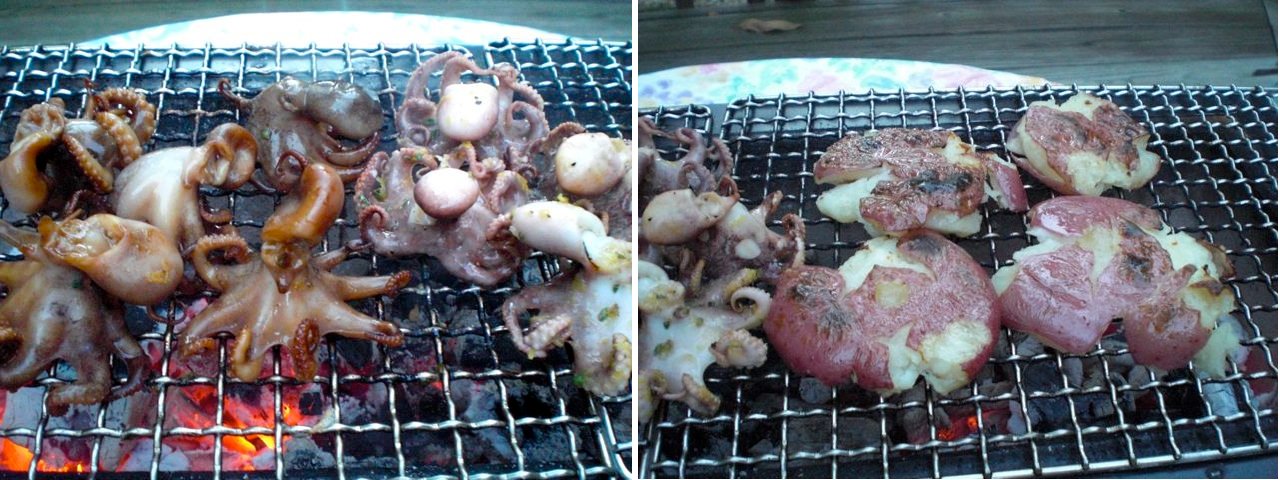
Both styles had lots of flavor, especially the Western version had nice lemony and thyme flavors. Only problem was that both were a bit chewy. For most Japanese, this degree of chewiness is Ok but not for most Westerners including my wife. I ended up cutting them into small pieces.
Our neighbor's dog showed up and hung around despite her owner's calling. She was not about to leave our barbecue. She may get in trouble if this continues.
Monday, October 18, 2010
Artichoke, acorn squash and rack of lamb アティチョーク、エイコーンスクワシュ, 子羊肉
This is certainly not Izakaya food. But I thought, just in case there are some Japanese readers out there, acorn squash and artichokes may be a bit unusual for them. Artichoke is a very strange vegetable (if it is a vegetable). It is the immature flower bud of a giant thistle. Whoever (must have been Europeans) decided this could be eaten, must have been very hungry. In terms of its strangeness and the fact that it is a flower bud, it is on par with myouga 茗荷. I didn't cook artichokes myself until I moved to California from the east coast many, many moons ago. We fondly remember driving through Half-moon Bay on the California coast, one of the major artichoke producing regions of the United States. We often stopped at one of the many road side stands to buy fresh artichokes just harvested from the fields that extended either side of the road. After moving back to the east, the artichokes we see at the market are usually pitiful and we only rarely buy them. Last weekend, I found some reasonably good looking artichokes and I could not resist buying them, but I did not have a chance to prepare them right away.
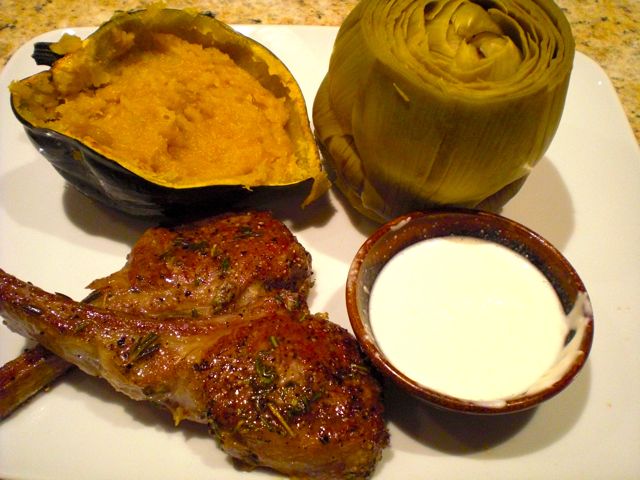
My wife came to the rescue and she prepared the artichokes along with acorn squash the following Friday. I only had to cook the rack of lamb that went along with them for dinner.
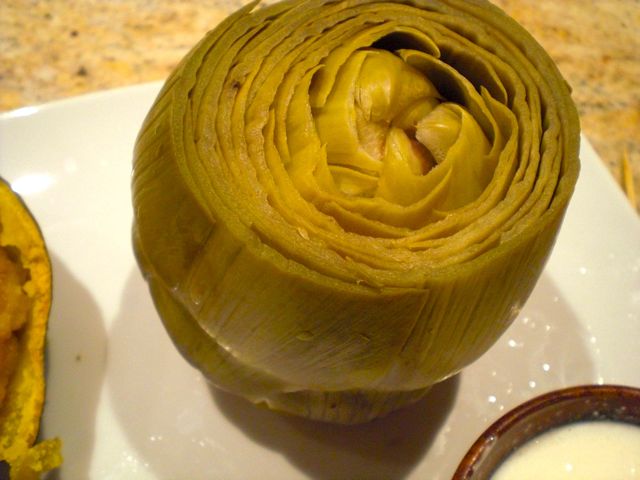
Artichokes: There are many ways to cook artichokes (which also depend on the size of the artichokes). The most classic old fashioned way for regular size artichokes is what we did this evening. How to clean and prepare artichokes is readily available elsewhere. My wife steamed them for 45 minutes in water to which lemon juice, onion, black pepper corns, bay leaf and olive oil had been added. The picture above shows the cooked artichoke served on the plate. What it doesn't show are the many outer petals that were already eaten in transit between pot and plate (It went swimmingly well with a sip of the red wine we were having).

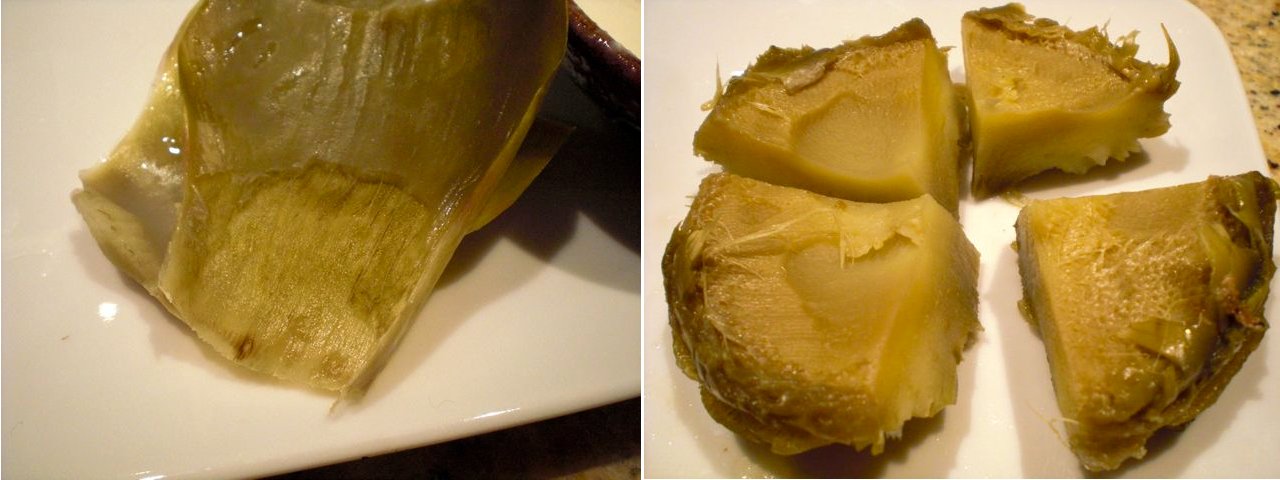 To eat, remove a petal, the edible portion is attached only to the bottom inside of the petal (above image, upper left), dip it in a whatever dip you like (the above image, upper right, is mayonnaise with lemon juice, but you could use melted butter as well) and using your front teeth, scrape off the edible portion (above image, lower left). When you get into the more immature inner petals, not much edible portion is attached. You then remove all the petals exposing the "chokes" (which, I suppose, eventually become the fluffy cottony stuff attached to the seeds to be carried by the wind). As the name implies, you do not want to put these chokes into your mouth. They are not named "chokes" for no reason. The name describes how you will feel if you attempt to eat it--choked. You must carefully remove all the chokes using a knife or spoon or both. You end up with the heart of the artichoke (the above image lower right, this one is already quartered). Actually, this is the meatiest and the best part of the plant. This is what the previous work was all about. The taste of artichokes is difficult to describe. We like it very much but you would have to taste it and decide for yourself.
To eat, remove a petal, the edible portion is attached only to the bottom inside of the petal (above image, upper left), dip it in a whatever dip you like (the above image, upper right, is mayonnaise with lemon juice, but you could use melted butter as well) and using your front teeth, scrape off the edible portion (above image, lower left). When you get into the more immature inner petals, not much edible portion is attached. You then remove all the petals exposing the "chokes" (which, I suppose, eventually become the fluffy cottony stuff attached to the seeds to be carried by the wind). As the name implies, you do not want to put these chokes into your mouth. They are not named "chokes" for no reason. The name describes how you will feel if you attempt to eat it--choked. You must carefully remove all the chokes using a knife or spoon or both. You end up with the heart of the artichoke (the above image lower right, this one is already quartered). Actually, this is the meatiest and the best part of the plant. This is what the previous work was all about. The taste of artichokes is difficult to describe. We like it very much but you would have to taste it and decide for yourself.
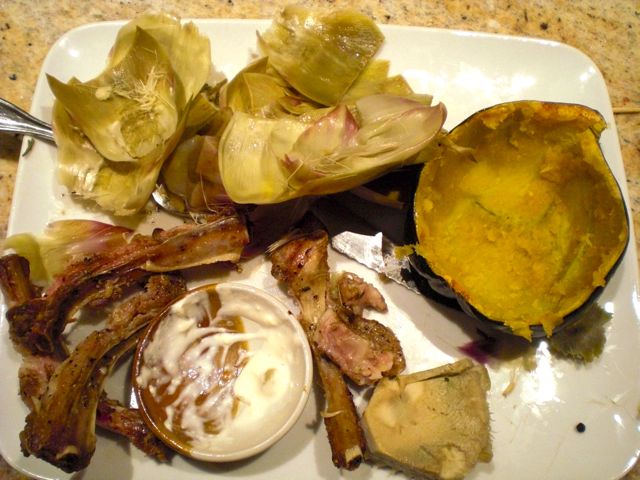
 The wine we had this evening was Benessere Vineyards Napa Valley Phenomenon 2005. This is a California red blend Super Tuscan style and made of Cab Sauv (47%), Sangiovese (27%), Merlot (14%) and syrah (12%), all from St. Helena estate-grown fruits. It is not like classic Napa cab with strong vanilla and chocolate but has a more subtle but complex taste. The tannin is now nicely matured giving a nice backbone to this California Super Tuscan. We like this wine very much. It went so well withthe lamb and artichokes. Perfect for tonight dinner.
The wine we had this evening was Benessere Vineyards Napa Valley Phenomenon 2005. This is a California red blend Super Tuscan style and made of Cab Sauv (47%), Sangiovese (27%), Merlot (14%) and syrah (12%), all from St. Helena estate-grown fruits. It is not like classic Napa cab with strong vanilla and chocolate but has a more subtle but complex taste. The tannin is now nicely matured giving a nice backbone to this California Super Tuscan. We like this wine very much. It went so well withthe lamb and artichokes. Perfect for tonight dinner.
Acorn squash: It is a very popular fall vegetable and my wife cooked it in the traditional American way but seasoned it with a Japanese touch. She cut the squash in half and removed the guts (seeds and inner membranes). She washed it under running water (leaving some water inside). The water puddles under the squash and steams it as it bakes. She then placed them on a flat cooking sheet with the cut-side down. The squash baked in a 350F oven for 45 minutes. She scraped all the meat out of the shells and put it in a bowl. She added butter, honey, and soy sauce (in lieu of salt), mixed well and then stuffed it back into the half shells. This tastes somewhat like mashed sweet potatoes but different. It has a mildly sweet taste yet is savory at the same time. This was a perfect side for the lamb (or more like, the lamb is perfect side for the squash).
Rack of lamb: This was seasoned with salt, pepper, and fresh rosemary. identically seasoned as ones in my previous post but I did not marinate and, instead of an electric grill, I browned it in a frying pan and finished it in an oven (350F 5-8 minutes).
Between the artichoke, squash, and lamb we noticed that this meal resulted in an unusually large amount of debris on the plate by the time we were finished. Doesn't this look the epitome of a good feast thoroughly enjoyed? In case you were wondering, it was.
Saturday, October 16, 2010
Perilla seedpod Tsukudani 紫蘇の実の佃煮
Aojiso 青じそ or green perilla is nice to have in your garden, especially if you are making any Japanese dishes as an ingredient as well as a garnish.The only problem is that this plant is like mint and is very prolific. It will reseed and take over the entire garden if you are not careful. When they start blossoming and making seeds, it is one of the signs of autumn for us. As you can see below, our small raised herb garden is dominated by perilla now with its flowers and seedpods.
I just poured the seasoning liquid of sake, mirin, and soy sauce (1:1:1) just to barely cover the seed pods and add the meat of two umeboshi 梅干し (pickled plum) cut up and also added their stones. I also added rice vinegar (2 tsp) at the very end. I am not sure how much of the seedpods I had to begin with but probably 3 cups or so. After 20-30 minutes with the lid slightly askew to encourage reduction, the liquid almost all evaporated and the pods become brown with the seeds visible (image below).
Wednesday, October 13, 2010
Stewed Pacific saury with Umeboshi さんまの梅煮
I posted sanma previously but I had two more frozen sanma left. I pondered what to make. Since it was a bit dry when grilled, I decided to make stewed sanma.

Here are two remaining sanma thawed (below). The innards are traditionally kept for this dish. Since this was previously frozen, I removed the innards. I cut the fish in three equal size potions.
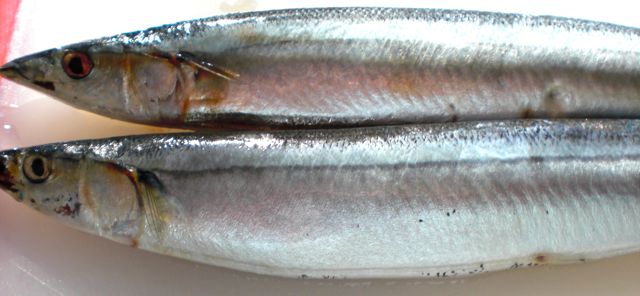
I washed and soaked the fish in salted cold water for 5 minutes to firm up the meat of the fish and then removed the excess moisture using paper towels (below left). For simmerig liquid, I first soaked two 2-inch long dried kelp pieces in 1 cup of cold water for a few hours. I placed the hydrated kelp pieces in the bottom of the sauce pan (to prevent the fish from sticking to the bottom of the pan). To the remaining broth (the kelp absorbed water, about 2/3 cup remained), I added mirin (2 tbs), sake (2 tbs), soy sauce (2 tbs), and rice vinegar (2 tsp). I also added the shredded meat of umeboshi (two) as well as their stones. Since I had ripe (red) Jalapeno peppers from our herb garden, I halved and seeded them but left the veins on and added them to the simmering liquid for some heat (or use dried red pepper). When it came to a simmer, I placed the fish into the pan. I put on a lid and simmered for 20 minutes and then let it cool in the liquid. Actually, we did not eat this the same day I made it. I put the pan in the refrigerator after it cooled to room temperature. I warmed it up the next day and served at room temperature.

I served it with a very thin julienne of fresh ginger (soaked in water for 10-15 minutes to remove the harshness) called "hari shouga" 針ショウガ and thin strips of scallion cut lengthwise and soaked in water. This preparation of scallion or "negi" is called "shiraga negi"白髪ねぎ or "white hair scallion". Since I did not have a thick Japanese scallion called "Tokyo scallion" in the U.S., it was difficult to make this from a small American green onion.
This was surprisingly good. The mild heat from Jalapeno was very nice. The meat was well seasoned and not dry and also much easier to remove from the bones compared to grilled sanma. For frozen sanma, this method of preparation appears better than grilling.
Tuesday, October 12, 2010
Three dishes with Miso mustard vinegar dressing からし酢みそ和え、三種類
I am not sure this is even worth posting. Here are three variations on the theme of "sumiso ae" 酢みそ和え.
1. Squid legs and crab salad イカのゲソとかにのからし酢みそ和え
2. Crab meat, semi-dried scallop, and sakuraebi カニ、貝柱、桜えびの酢味噌和え
3. Baby octopus, snake-belly-cut cucumber and tomato 子鮹と蛇腹切りのキュウリの酢みそ和え
Monday, October 11, 2010
Barbecued Cornish Game Hen 若鶏のバベキュー
This is certainly not Izakaya food but this small young chicken must be rather unique to the U.S. and I decided to post this dish. Exactly what is Cornish game hen is not really clear; whether this is a just young regular chicken or descendants of the original cross breed of Cornish game cocks and Rock hens (from which the name derived) in 1950 or similar cross breed developed later (1965) by Tyson food. But since the vast majority of "Cornish game hens" are supplied by Tyson, whatever cross breed that Tyson may have developed must be what we are eating here. Because of its small size, it is perfect to serve one whole bird per person. In the past I've served these birds instead of a big turkey for such occasions as Thanksgiving. For us, half of the bird is usually enough. We like this small bird since the meat is more tender and juicier than regular chicken, albeit it may not have a strong taste. I have never seen this bird in Japan but, apparently, Tyson brand can be had by mail order in Japan.
This could have been what we served if Jon had visited us along with no-crapple scrapple. The way I barbecue Cornish game hens is near identical to the recipe for regular chicken. I first squeeze the juice from two wedges of lemon inside and out the chicken and generously salt and pepper inside the cavity. I put the lemon wedges (the ones I used for the juice), coarsely chopped onion, crushed and skinned garlic cloves (as many as you like), and finely chopped fresh rosemary in the cavity. (Things have to be cut relatively small to stuff the small cavity of the bird). I truss it. I smear olive oil on the outside of the chicken and again generously coat the skin with salt and black pepper. I hot smoke/barbecue in a Weber kettle using indirect heat. This time I used hickory chips for smoking. I cook until the deepest part of the thigh registers 165-170F. I let it rest for at least 10 minutes.
My wife made mashed potatoes which were quite excellent. We used small (or baby) Yukon gold potatoes. After removing the "eyes" (leaving the skin on), she just wrapped several potatoes together in aluminum foil and put them along side the chickens in the Weber. The chicken took almost 45-50 minutes to cook and during that time, the potatoes were perfectly done. She mashed the potatoes and added salt, pepper, and very, very finely chopped red onion (this adds a nice burst of onion flavor to the bite), and creme fraiche instead of butter.
I also briefly grilled blanched and oil coated asparagus.
We think this is the best way to cook (hot smoke barbecue) and enjoy a chicken. Cornish game hens are particularly elegant (we think) when the whole bird is served per person. Although I have tried stuffing the cavity with porcini mushroom and grapes, or stuffing the space under the breast skin with herbs/goat cheese mixtures etc, we settled on the current simple method. Of course, you need to use your fingers to eat the bird, at that point, "elegance" is out-the-window.
Subscribe to:
Comments (Atom)
